3 Ways Fonio Is a Boost for Sustainable Agriculture
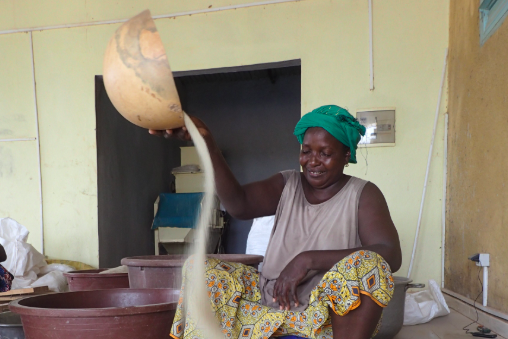
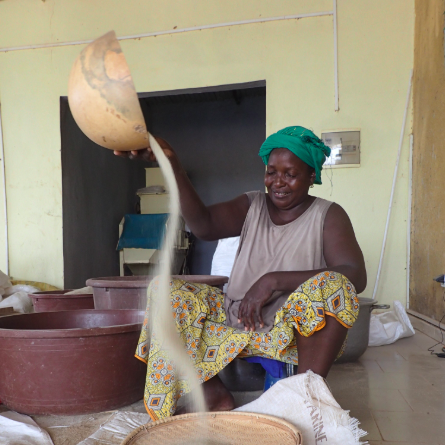
Fonio, an ancient grain from the semiarid regions of western and north-central Africa, is gaining popularity in the U.S. food market for its high fiber and protein content.
Companies are investing in partnerships and operations to distribute fonio globally. For example, Terra Ingredients, a supplier of organic and natural packaged foods, plans to open a processing plant in Senegal in 2020 to increase exports of fonio to thousands of tons annually. Such a processing plant is essential to expand fonio distribution since removing the fonio grain from the husk is labor-intensive. Yolélé Foods, a fonio supplier, plans to bring new fonio products to store shelves in 2020 in partnership with Whole Foods Market.
Read on to learn how fonio’s rise bears well for not only our taste buds, but also for the farming communities that grow it and our planet’s well-being.
Fonio’s flavor and health benefits make it easy for U.S. consumers to adopt
The Washington Post and Cooking Light are among the publications that claim fonio is the “new quinoa.” Its nutritional content fits U.S. eaters’ growing demand for gluten-free and vegan options. Unlike other whole grains, fonio contains high levels of methionine and cysteine, amino acids associated with liver detoxification and collagen health, and holds a low glycemic index.
Restaurants’ adoption of fonio showcases its unique flavor and versatility. Erik Oberholtzer’s Tender Greens uses it for its tabbouleh, Fast Company reports. And Chef Pierre Thiam’s Teranga in Brooklyn serves up a beet and fonio salad, as well as a fonio vegetable super bowl. Thiam is known as “the chef behind America’s new favorite supergrain” since he’s spent more than 10 years introducing the grain to Americans through TED Talks, cookbooks and his fonio supplier company, Yolélé Foods.
“Thiam wanted to show Americans that the grain could be just as exciting as any other ingredient New York chefs were cooking with, while also creating an outlet for West African farmers to sell their harvests,” wrote Elazar Sontag in Bon Appetit.
Fonio provides food security and income generation for farmers
Thiam’s Yolélé Foods and the U.K.’s Aduana Superfoods see rising global demand for fonio as an opportunity to support income generation and food security for rural communities along the Sahel belt in Africa. The potential for infrastructure and job growth in communities that grow this grain is significant as 95 percent of the 600,000 tons of fonio produced globally is consumed within the communities where it is grown.
Aduana Superfoods perpetuates responsible community development through its distribution model. The brand sources fonio directly from hundreds of women smallholders. It is committed to buying only 80 percent of the fonio produced by communities, leaving the rest for local consumption, according to Food Ingredients First.
In the past 20 years, researchers have only published 19 brief scientific articles on fonio despite its role in feeding many communities in the Sahel region. Thiam sees fonio’s low profile, until recently, as a result of many Africans’ belief that their native crops are inferior to imports, which is among the many long-term effects of colonization. The fonio boom could change this mindset as Western African countries become exporters, according to The Washington Post.
Fonio requires less water and can reduce supply chain risk
Fonio’s growing distribution is a win for sustainable agriculture. Its introduction into more diets diversifies our global reliance on 150 out of the 30,000 edible plant species. Having more diverse crop offerings mitigates supply chain risk and reduces the need for fertilizers, according to the Alpha Food Labs, a futurist food lab.
Fonio often grows in harsh growing conditions — including droughts, acidic soil and floods — which is crucial since 2019 was recorded as the second hottest year on record. Fonio is a go-to for farmers, no matter what weather events occur during the growing season, since farmers don’t need to prepare the soil before planting fonio.
“There are so many challenges that these farmers are facing, but if the rainy season is not good, they know that at least one rain can guarantee them a harvest of fonio,” Thiam told The Epoch Times. “It’s important for the survival of the [Sahel] region.”
Image credit: James Courtwright/Wiki Commons
Mastercard CEO: Climate Action is About Survival, Not Altruism
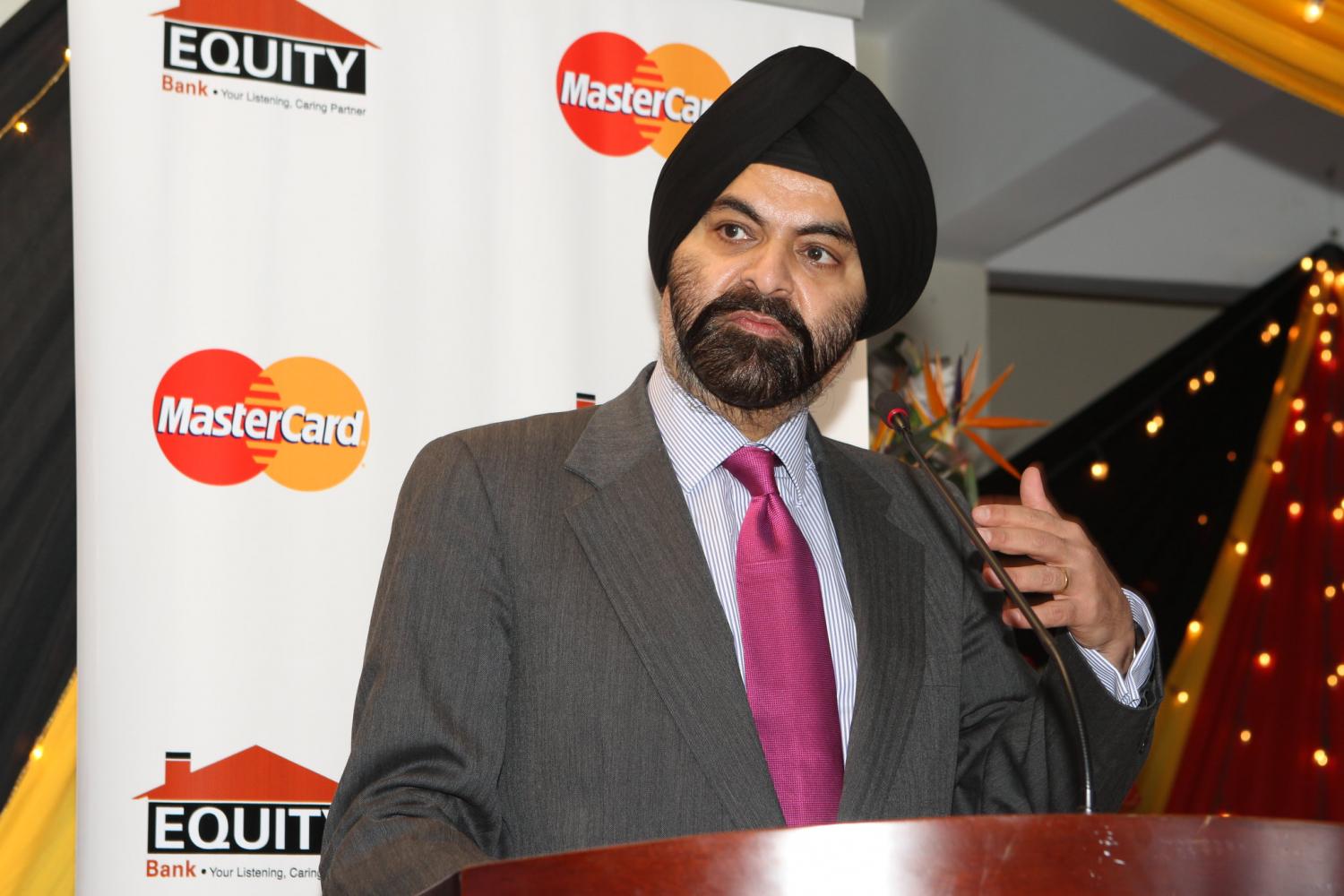
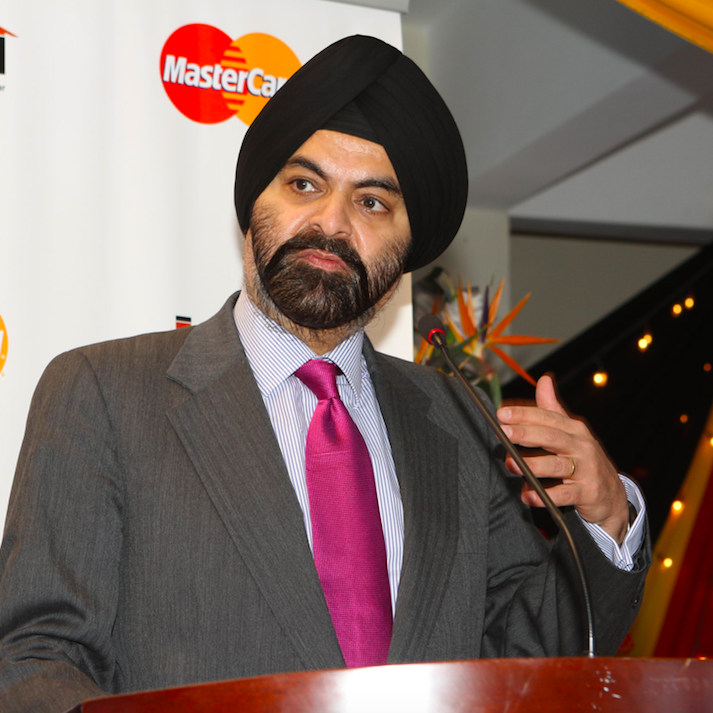
On Friday, Mastercard president and CEO Ajay Banga said out loud what others have been thinking: Businesses can no longer afford to approach climate action as a form of eco-friendly altruism. The potential for catastrophic bottom-line impact is coming into clear focus, and the only way companies can protect themselves is to take steps that reach far beyond their own walls.
Climate action is a matter of survival
Banga, who also sits on Mastercard's board of directors and is among the global finance-sector CEOs attending the World Economic Forum in Davos, published his new climate action manifesto on the company's website under the title, “The Time For Environmental Altruism is Over.”
Just a few years ago, that kind of thinking would have landed on the corporate responsibility universe like a bombshell. After all, Banga explained, companies like Mastercard have already taken many steps to decarbonize internally.
Companies are converting their operations to renewable energy, adhering to green building standards, replacing petrochemicals with alternative products, and zeroing out landfill waste, among many other steps. They are also motivating — or outright dictating — similar changes in their supply chains and consumer value chains. In the arena of climate action, what else is left to do?
Plenty, Banga argues. Climate change is an existential threat. If companies want to continue turning a profit, they cannot simply focus on cleaning up their own mess. They have to act globally, he asserted. They need to reach out and form partnerships that create an impact outside of their own operations, supply chains and consumer webs.
Partnering up to accelerate climate action
A collaborative approach to decarbonization has been building over the past several years, as corporations realize the value of partnering with grassroots environmental groups, government entities, and other businesses for maximum impact.
Mastercard’s new climate action plan takes that strategy and ramps it up another notch through a partnership called the Priceless Planet Coalition.
It’s an interesting mix of partners. On the business side, it includes the financial giants Citibank and Santander U.K., the information and consulting firm IHS Markit, and the mobile banking company Bunq, along with American Airlines and top retailers Saks Fifth Avenue and L.L. Bean.
On the government side are two behemoths of the transportation sector, New York Metropolitan Transport Authority and Transport for London. Rounding out the network are the environmental organizations Conservation International, World Resources Institute and One Tree Planted.
Putting one simple idea in motion
With Bunq and One Tree Planted in hand, the Priceless Planet Coalition has a head start on its first big project, a five-year effort to plant 100 million trees.
One Tree Planted is already involved in a partnership with World Resources Institute and the U.S. Forest Service, which funds specific reforestation projects by pooling $1-per-tree donations into larger sums. The current target regions are North America, Latin America, Africa and Asia.
One Tree Planted also offers a “Million Tree Challenge” for businesses to participate on a larger scale. The companies receive recognition and branding in return for their donations.
On its part, Bunq offers customers a “green” credit card that pledges one new tree for every 100 euros ($111) spent.
Connecting the dots
The other partners have also taken steps in the tree conservation area. Saks, for example, paired up with the sustainable packaging company Emerald Brand in 2016, and L.L. Bean has been working with Trees For the Future since 2007 through the footwear company Oboz.
Meanwhile, part of American Airlines’ sustainability plan involves reducing paperwork in its air cargo operations. That may sound like a minor change, but the impact will be significant, as the company explains:
“Did you know our air cargo industry prints roughly 7,800 tons of paperwork every year? That's 100,000 trees and enough paper to fill 80 747 freighters. That's why we're fully committed to the industry's eAWB initiative. We're dead-set on getting to 100 percent eAWB use from all of our customers.”
By putting all of these pieces together, the Priceless Planet Coalition will enable the participating companies to ramp up their green profile by orders of magnitude.
Climate action and trees
There’s just one drawback with this approach. Planting trees on a massive scale is widely acknowledged to be the least costly and the most effective pathway for capturing and storing excess carbon in the air.
However, until the Earth’s top carbon emitters get serious about renewable energy and stop touting solutions like “cleaner” natural gas and carbon capture technology, Priceless Planet will only accomplish on a grander scale the very situation that Banga warns against: negating carbon emissions without reducing them.
In other words, more trees will enable more fossil fuel production, without accomplishing anything to reduce it.
Priceless Planet could achieve one important step, though. By raising awareness that tree-planting on a massive scale will not stop fossil fuel stakeholders from releasing more carbon into the atmosphere, it could help create momentum for stronger climate action policy on the part of governments.
After all, if even the combined efforts of finance industry giants like Mastercard, Santander and Citibank only add up to a global form of wheel-spinning on climate action, someone has to attack the problem at its root.
Image credit: Mastercard/Flickr
A Second Chance for the Restaurant Industry to Speak Out on Immigration Reform
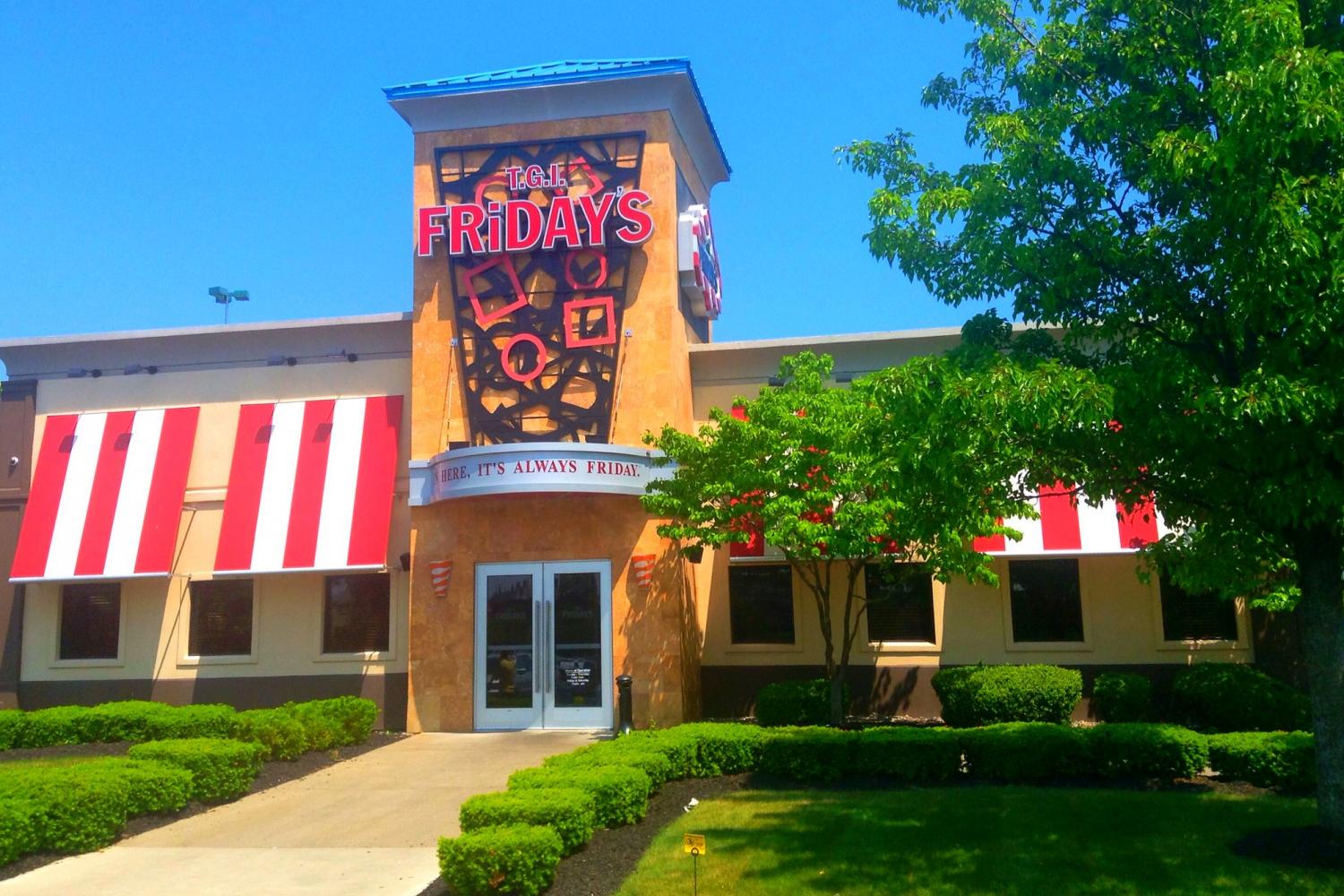
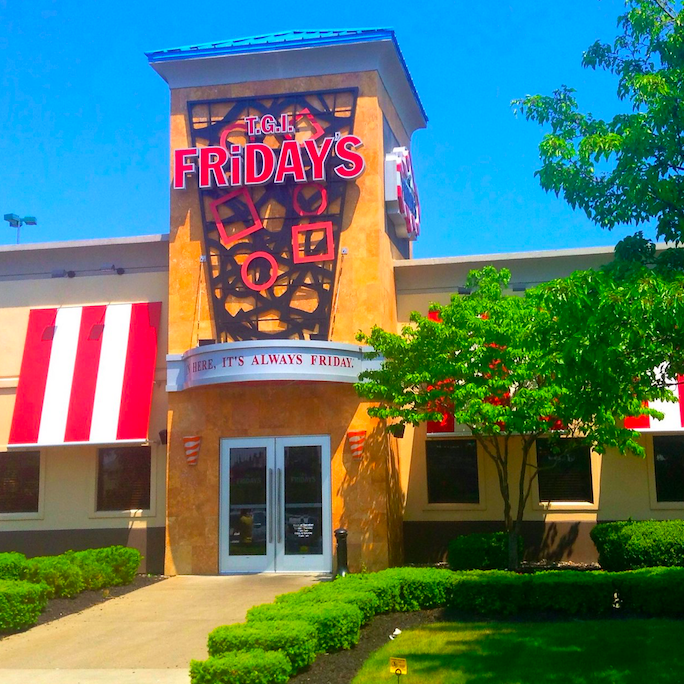
The CEO of TGI Fridays, Ray Blanchette, went on record last week calling for immigration reform. Around the same time, news surfaced that the Donald Trump administration has begun to focus on deporting immigrants from Southeast Asia. The question is: Will business leaders step up and advocate for immigration reform in time to make a difference, or will they let another lost opportunity slip through their fingers?
Behind the curve on immigration reform
The Trump administration took office in January 2017, with one of its goals to crack down on what the president and his supporters view as unchecked immigration.
Tech companies responded forcefully from the start, and that sector continues to lead the push for reform. In contrast, the restaurant industry has taken a more low-key approach.
Since last summer, though, the industry has been “on edge” as the Trump administration reportedly gears up to arrest immigrants at their places of work, which are often in restaurants.
In a conversation with Business Insider last week, Blanchette explained why the restaurant industry needs to stay ahead of the labor reform curve in general and immigration reform in particular.
He remarked that the industry lost an opportunity to support a $10-per-hour minimum wage during the Barack Obama administration. Now, with momentum building for a $15-per-hour rate for American workers, the industry has to find ways to cope with an even more onerous wage scenario.
In a similar vein, Blanchette argued that the industry’s failure to make the case for sensible immigration reform over the years has come back to haunt it. The U.S. labor market is already tight. With immigrants no longer in sufficient numbers to take low-paying jobs, restaurants are scrambling to staff up, and there is a clear bottom-line motivation to advocate for change.
Now is the time for immigration reform
Blanchette’s remarks coincided with an NBC News report on a new shift in focus for the Trump administration’s immigration policy.
The administration has “quietly” deported about 25 Cambodian immigrants, mainly consisting of persons who have lived in the U.S. since arriving as refugees in the 1970s, after the Vietnam War, NBC reported.
Though the outlet was informed that the deportees had been convicted of crimes, in most cases it appears that the convictions were decades old, and the deportees had firmly established productive lives in their communities. Many are leaving family members and other dependents behind while facing an uncertain future in a country that does not want them back.
Cambodia has a strict policy on repatriating former refugees, and according to the organization Asian Americans Advancing Justice, many of the deportees were not born in Cambodia. For the most part, they were born in refugee camps and have never been to Cambodia.
A way forward on immigration reform?
All of these factors are consistent with the characteristics of previous mass deportations during the Trump administration. Rather than focusing on current criminal behavior, the administration has prioritized specific groups for enforcement regardless of their status in their communities.
In this context, Blanchette’s call for sensible immigration is a timely one — and a readymade platform for action is already available.
The Trump administration often leverages strict immigration laws passed during the Bill Clinton administration to enforce its policies, but the U.S. House of Representatives is working on a bill called the New Way Forward Act, which would loosen those restrictions.
The New Way Forward Act would provide immigrants facing deportation with more opportunities to remain in their communities until their case is settled. It would also give judges much more leeway to provide relief from deportation in cases of special need.
In a direct challenge to the decision behind deporting that group of Cambodian refugees, the bill also holds that a criminal conviction or charge “may not be the sole factor” to justify detention.
Immigration reform that everyone supports
The legislation also contains provisions that would end federal contracts with private companies for immigrant detention facilities and other detention programs.
When linked to the notorious family separation policy, the private prison issue has swayed public opinion. In effect, it has created a safe space in which business leaders can advocate for immigration reform.
For business leaders, the situation is similar to the gun safety movement. For many years, business leaders concerned about gun reform advocated in isolation. Now there is a strong grassroots gun reform movement backed by public opinion, and more businesses are beginning to advocate in public.
As a similar wave of advocacy builds for immigrant rights, now is the time for the restaurant industry to lead, not follow.
Image credit: Mike Mozart/Flickr
Nestlé is Investing Billions To Develop a Market for Recycled Plastic
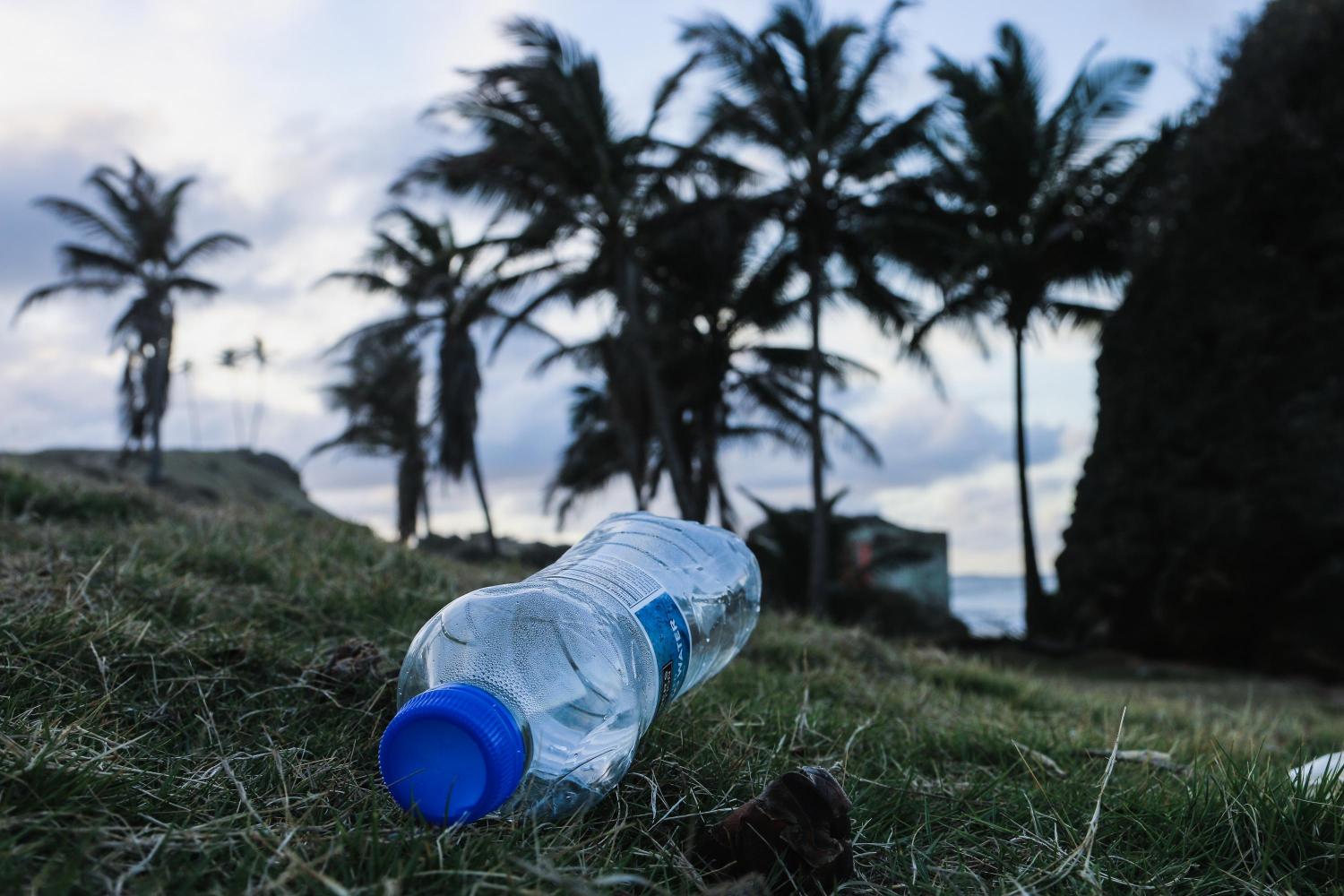
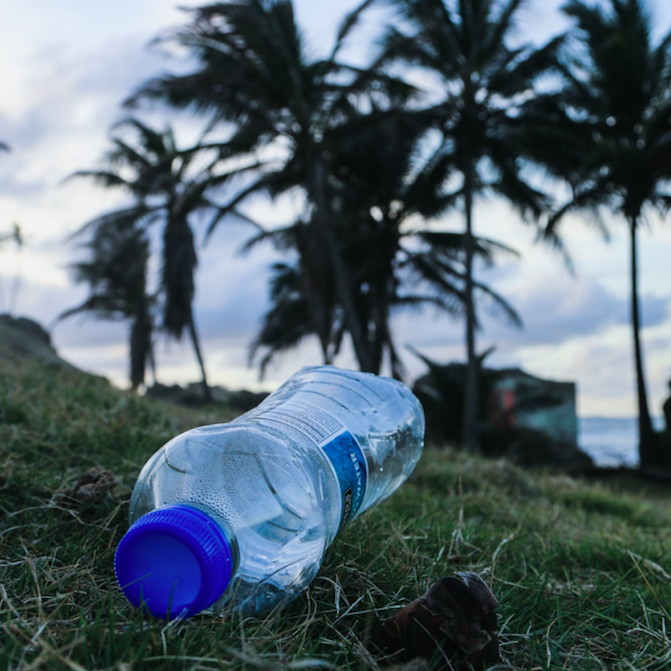
Nestlé says it's getting serious about dealing with plastic packaging waste. Last week, the consumer goods giant announced it will invest up to $2.64 billion to create a market for food-grade recycled plastic. This news follows Nestlé's 2018 commitment to make 100 percent of its packaging recyclable or reusable by 2025 and reduce its use of virgin plastics by a third.
To work toward that commitment, Nestlé pledged to source up to 2 million metric tons of recycled plastics and will allocate more than $1.5 billion to pay for these materials through 2025. Further, the company behind brands like Nespresso and Purina created a $258 million sustainable packaging venture to invest in startups in this space.
Nestlé says it will cut costs in other parts of its operations to free up funds to keep these commitments. The company stated that it will “pay a premium” for recycled plastic as part of its strategy to create a market for food-grade recycled plastic.
These efforts to create a market for recycled plastic works toward its goals to achieve zero environmental impact in its operations by 2030 and zero net greenhouse gas emissions by 2050. In addition to these big goals, the food and beverage giant has several smaller commitments. One of them is avoiding the use of at least 140,000 tons of packaging from 2015 to 2020. To date, the company says it has avoided 118,710 tons of packaging.
“We are taking bold steps to create a wider market for food-grade recycled plastics and boost innovation in the packaging industry,” said Mark Schneider, CEO of Nestlé. “We welcome others to join us on this journey.”
The challenge Nestlé and the food industry face with recycled plastic
Food packaging waste, in general, is a stubborn problem. Containers and packages accounted for 29.9 percent of all municipal solid waste in 2017, with a recycling rate just above 50 percent. Specifically, plastic food packaging waste is an even bigger problem. Although comprising only 5.3 percent of municipal solid waste in 2017, the recycling rate for PET bottles and jars was 29.1 percent. But the overall recycling rate for plastic containers and packaging was a mere 13 percent the same year.
Plastic food packaging not recycled goes to landfills where it emits methane, a greenhouse gas 30 times more potent than carbon dioxide, or ends up in the world’s oceans. There is an estimated 150 million metric tons of ocean plastic waste globally, and 8 million metric tons of new plastics enter the ocean every year. Small pieces of plastic look like food to marine animals, and plastic has been discovered in more than 60 percent of seabirds and in 100 percent of sea turtle species. Plastic ingested can cause life-threatening problems to both wildlife and humans.
Is recycled plastic the only solution to plastic food packaging waste?
There is a growing market for recycled plastic. The value of the global recycled plastics market was $40.26 billion in 2018. By 2026, it is expected to reach $66.74 billion, with a compound annual growth rate of 6.5 percent. But is recycling the only option for dealing with plastic packaging?
Perhaps efforts to reduce single-use packaging are an even better option, some say. Matthias Wüthrich, senior campaigner at Greenpeace Switzerland, warns that Nestlé should not turn to “false solutions such as recycled content and material substitution.” Instead, the company needs to “end its reliance on plastic,” he said, by investing in “new business models instead of just buying recycled plastics.”
More than 450 businesses, governments, and other organizations have pledged to reduce the need for single-use plastic packaging as part of the New Plastics Economy Global Commitment. The signatories include companies representing 20 percent of all plastic packaging produced globally, and Nestlé is one of them.
Image credit: Brian Yurasits/Unsplash
Starbucks to Halve Carbon Emissions by 2030 As Part of 'Resource Positive' Vision
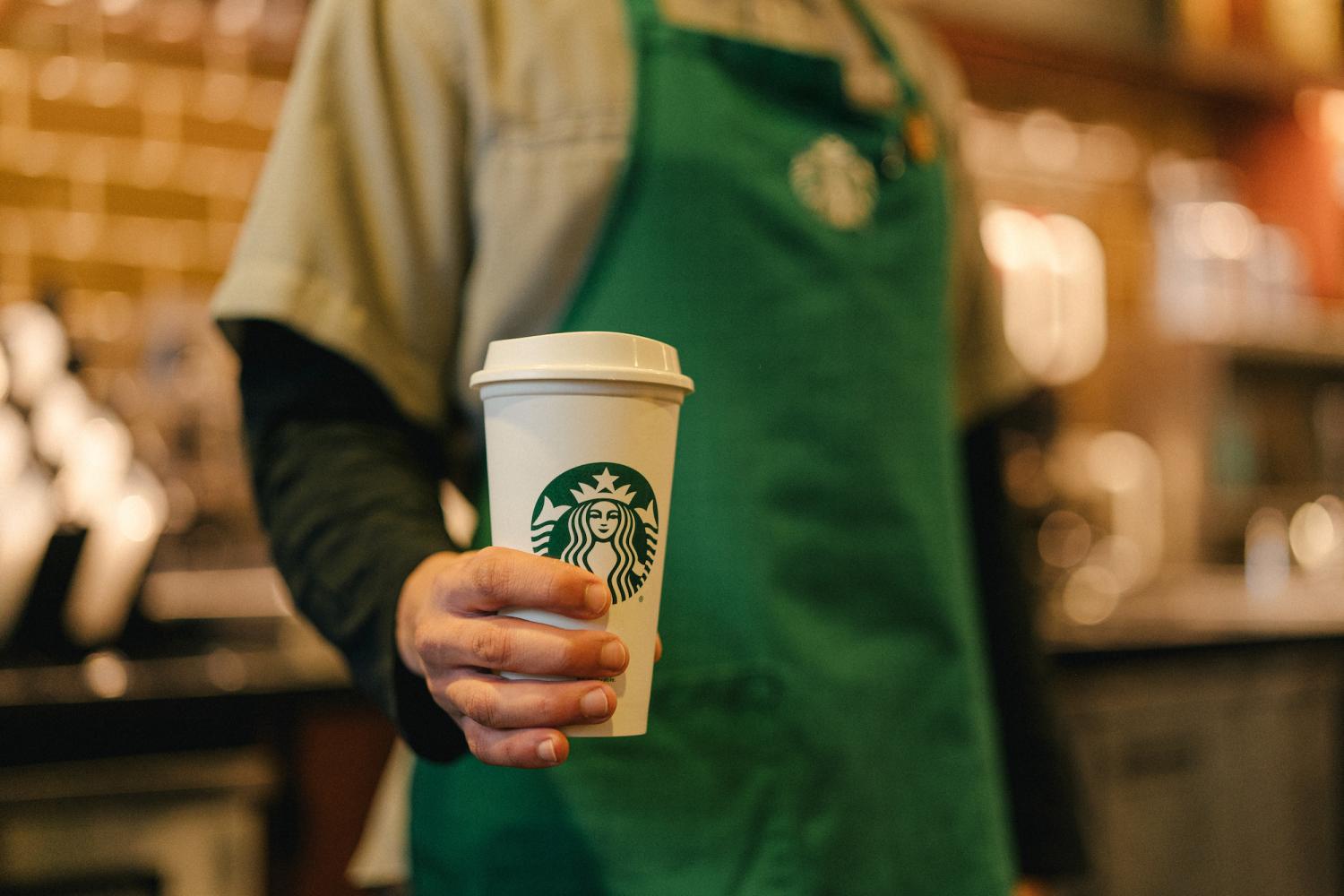

(Image: Incentivizing the use of reusable cups like this one is just one way Starbucks hopes to become "resource positive.")
Starbucks plans to halve carbon emissions, water use and waste by 2030 as part of a long-term vision to become a "resource positive" company.
CEO Kevin Johnson laid out the plan in a letter released today and addressed to Starbucks employees, customers and other stakeholders. "Our aspiration is to become resource positive—storing more carbon than we emit, eliminating waste and providing more clean freshwater than we use," Johnson wrote.
The coffee giant will conduct market research on factors related to its 2030 goals and formalize those targets in 2021—its 50th year in business—based on lessons learned. "As we move forward, we will be transparent in reporting short- and long-term progress against our goals," Johnson promised stakeholders in his letter.
Starbucks' resource positive vision
Last year, Starbucks worked with the World Wildlife Fund (WWF) and Quantis to assess the carbon emissions, water use, and waste associated with its operations and supply chain. This was the first time the company conducted a footprint assessment for all three of these areas globally—and the findings informed both its 2030 goals and its long-term vision, Rebecca Zimmer, Starbucks' global director of environment, told TriplePundit.
"The findings from that audit drove us to where we had our biggest areas of opportunity, as well as the challenges we needed to solve for," Zimmer said. "It was also very informative in terms of what strategies could be deployed."
Using benchmarks from the analysis, Starbucks identified five long-term strategies that will underpin its resource positive vision. These tactics include expanding plant-based menu options, switching from disposable to reusable packaging, and investing in regenerative agriculture, forest conservation and water replenishment, Johnson detailed in his letter.
Environmental groups praised this long-term trajectory in testimonials gathered by Starbucks and distributed to reporters. “It is encouraging to see Starbucks embrace a data-driven and team-driven approach to creating a resource positive future," Mark Lee, executive director of the environmental consultancy SustainAbility, said in a statement. "Their most senior leadership was directly involved in the creation of this plan."
"This is exactly the kind of leadership we need to see from businesses—an opportunity to invest in their own future while making their global customer base a partner in this sustainability journey," added Sheila Bonini, senior vice president of private-sector engagement for WWF.
Halving carbon emissions: A science-based approach to climate action
Starbucks' commitment to halve global carbon emissions by 2030 aligns with the Paris climate agreement, and the company will use Science-Based Targets initiative (SBTi) methodology to measure progress moving forward.
"We agree with the consensus of scientific experts who note that without drastic action from everyone—governments, companies and all of us as individuals—adapting to the impact of climate change in the future will be far more difficult and costly," Johnson wrote.
The target builds on Starbucks' prior track record of setting forward-thinking goals and sticking with them, he asserted. For example, the company worked with Conservation International for nearly two decades to ethically source 99 percent of its coffee through C.A.F.E. (Coffee and Farmer Equity) practices. Reaching this milestone "more than halved what our coffee’s carbon footprint would have been otherwise," Johnson wrote.
Water: Meeting local challenges head-on
Under a 2018 commitment, Starbucks pledged to build 10,000 so-called "Greener Stores" by 2025. In this case, the company defines "greener" as a store that's powered by 100 percent renewable energy and uses 30 percent less water than its conventional counterparts, among other factors.
A $1 billion green bond launchd in May 2019 will fund further efforts toward the 2030 water goal, as well as other sustainability efforts at the company.
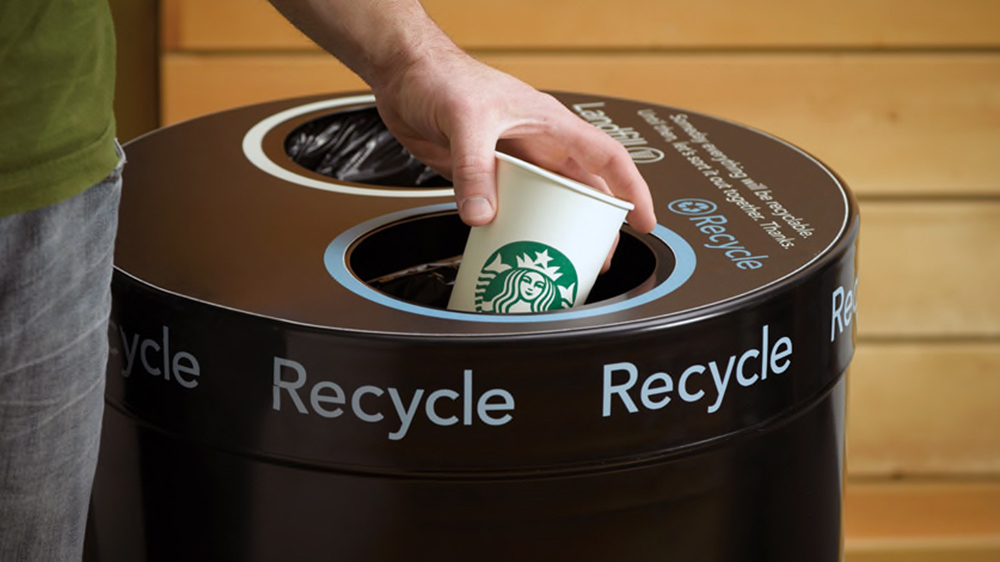
Waste: An Achilles heel, or an opportunity for engagement?
Starbucks fell short of an ambitious 2008 recycling goal that was "largely dependent on radical changes in customer behavior," underscoring "the need for a different approach," Johnson wrote. This will be a key focus of market research and trials in 2020. Specifically, the company is looking to "better understand consumer behavior and incentives to encourage consumer use of reusable containers," he continued.
The company joined the Ellen MacArthur Foundation's New Plastics Economy Global Commitment as part of today's announcement, which requires signatory companies to make all packaging reusable, recyclable or compostable by 2025.
Some trials are already underway—including a takeaway cup fee implemented in the U.K. in 2018 and set to expand to Germany this year. Starbucks stores are also using more ceramic cups for beverages consumed in house, particularly in markets like Europe and the Asia Pacific, where customers are more likely to linger than take their drinks to go, Zimmer said.
"There will be different models, and the consumer and market research we're doing will help us inform how best to succeed alongside our customers in this journey," she told us.
The bottom line
Starbucks is one of several companies to release environmental announcements ahead of the World Economic Forum in Davos, Switzerland, later this week. Visa achieved its goal to use 100 percent renewable energy. PepsiCo plans to do the same for its U.S. operations by the end of this year. And Microsoft pledged to become “carbon negative” by 2030, among other news.
For his part, Johnson underscored that Starbucks is still committed to a long-term growth model anchored by double-digit increases in earnings per share, with a clear inference that environmental strategies will help—not hurt—that vision.
"By embracing a longer-term economic, equitable and planetary value proposition for our company, we will create greater value for all stakeholders," he wrote. "The journey we undertake is not only the right one for Starbucks' responsibility as a corporate citizen of the world but is also fundamental to our brand relevance and, therefore, our overall business results."
Images courtesy of Starbucks
The Top 8 Sustainable Packaging Innovations of 2019
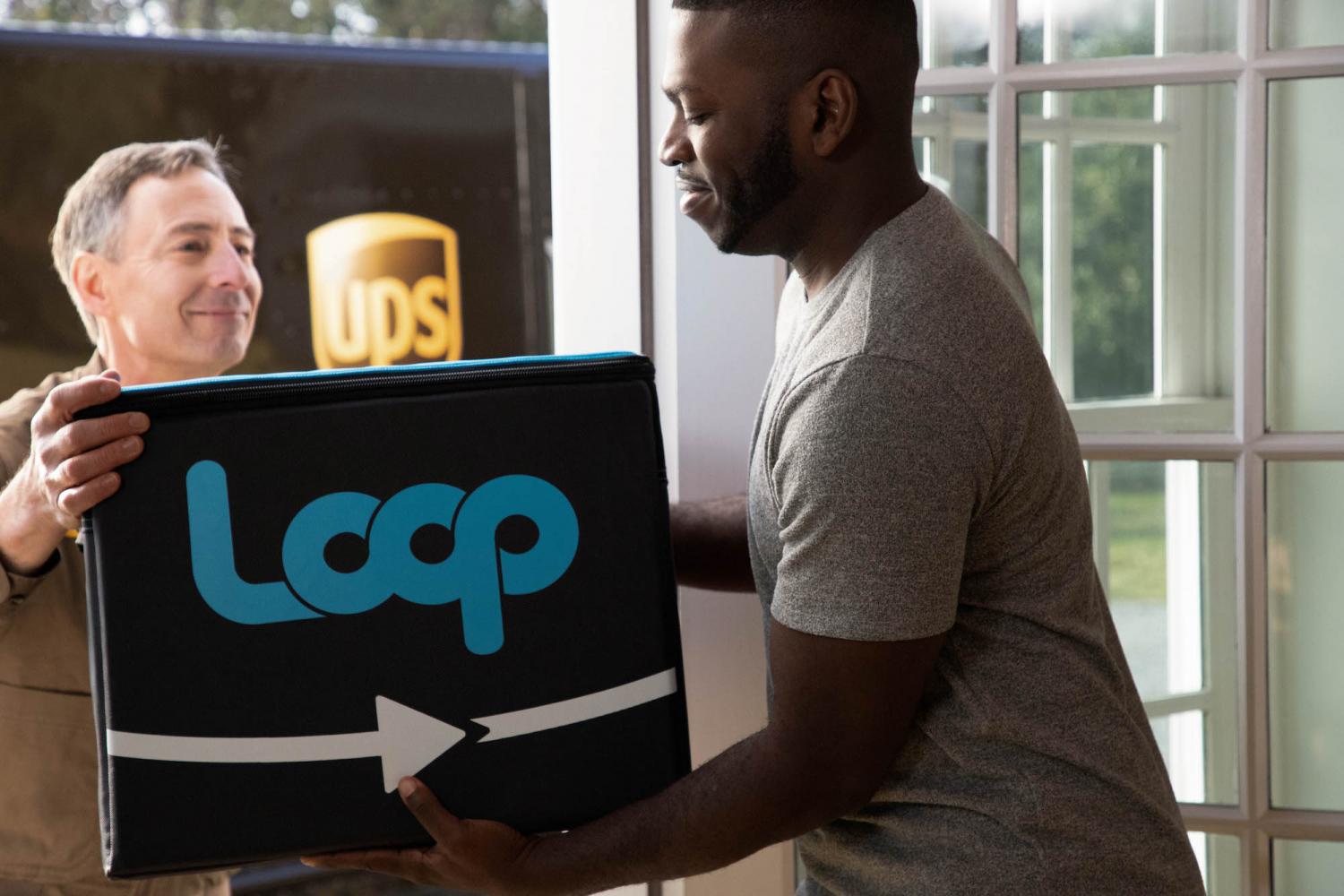
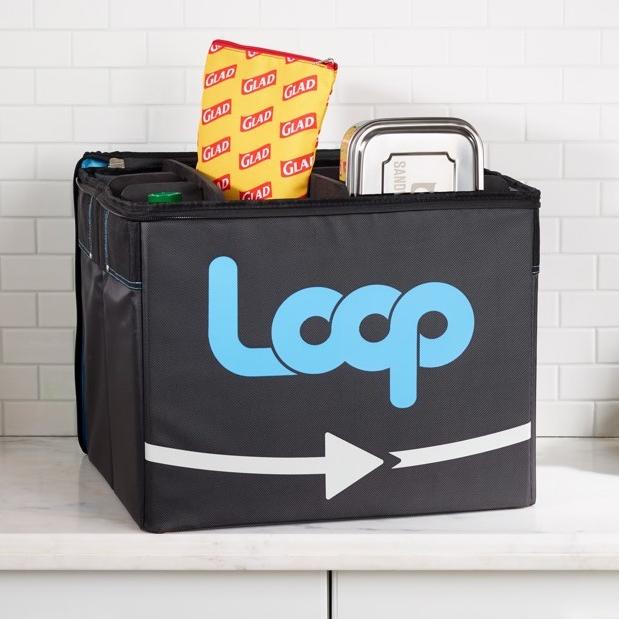
Consumer demand for sustainable packaging is on the rise as people wise up to the dark side of single-use convenience and grow more willing to adjust their behavior.
More than 70 percent of U.S. consumers say they intentionally reduced their plastic consumption to some extent in 2019, according to market research published last week. And brands responded with sustainable packaging innovations that attracted mainstream attention while making measurable impact. Read on for some of the sustainable packaging standouts that crossed our desks last year.
Loop zero-waste shopping service grows fast
Essentially, Loop takes us back to the milkman system—only with way more products and an e-commerce twist. Subscribers choose from mainstream products in an online store, and the items are shipped directly to their door in a reusable tote. When the products are gone, customers simply place the containers back into the tote and schedule a free pickup at their home. Loop cleans and refills them before shipping them out to someone else.
The sustainable packaging system was first announced at the World Economic Forum in January 2019 and launched in metro New York and Paris a few months later. Today, it's available in nine states across the Northeastern U.S., plus Washington, D.C, with plans for further expansion in the U.S., U.K., Canada, Germany and Japan.
And that's not the only way Loop is expanding: Having launched with major companies like PepsiCo, Procter & Gamble, Unilever and shipping partner UPS, it now includes 42 brands ranging from Pantene and The Body Shop to Tropicana and Häagen-Dazs. It's adding around one new brand per day, founder Tom Szaky (also CEO of upcycling platform TerraCycle) said in October, and is clearly a concept to watch.

Cleaning product concentrates hit the mainstream
Concentrates are nothing new, but they had a real moment in 2019. For those who aren't familiar, the concept is pretty simple: Concentrate products contain only active ingredients and are combined with tap water in reusable bottles, minimizing the packaging and transport of containers filled mostly with water.
Mainstream brands like SC Johnson, Unilever, and Procter & Gamble expanded their roster of concentrates in 2019 or created new Iines for concentrate products. Meanwhile, a handful of upstart brands—including ThreeMain and Blueland—made a splash with stylish designs and nontoxic concentrates that received a warm reception on social media. The latter—Boston-based ThreeMain, which launched in 2018 and rolled out nationwide last year—cuts plastic use even further thanks to reusable spray bottles made from aluminum.

Beauty companies bring refillables back to the sustainable packaging game
Yes, in 2019, everything old was new again—and refillable beauty packaging was back in vogue. Well-known brands like Stila, MAC and Jane Iredale offered refillable cosmetic compacts in the early part of the decade (and still do). But the practice largely fell out of fashion as influencer culture drove brands toward more extravagant packaging that stands out in social media feeds.
Last year, as sustainability emerged as a top purchasing driver, more companies seemed keen to revive refillables. Brands including Yves Saint Laurent, Bond No. 9, L’Oréal Professionnel and Kat Von D Beauty launched refillable products in 2019. Olay also piloted a refillable version of its Regenerist Whip moisturizer.
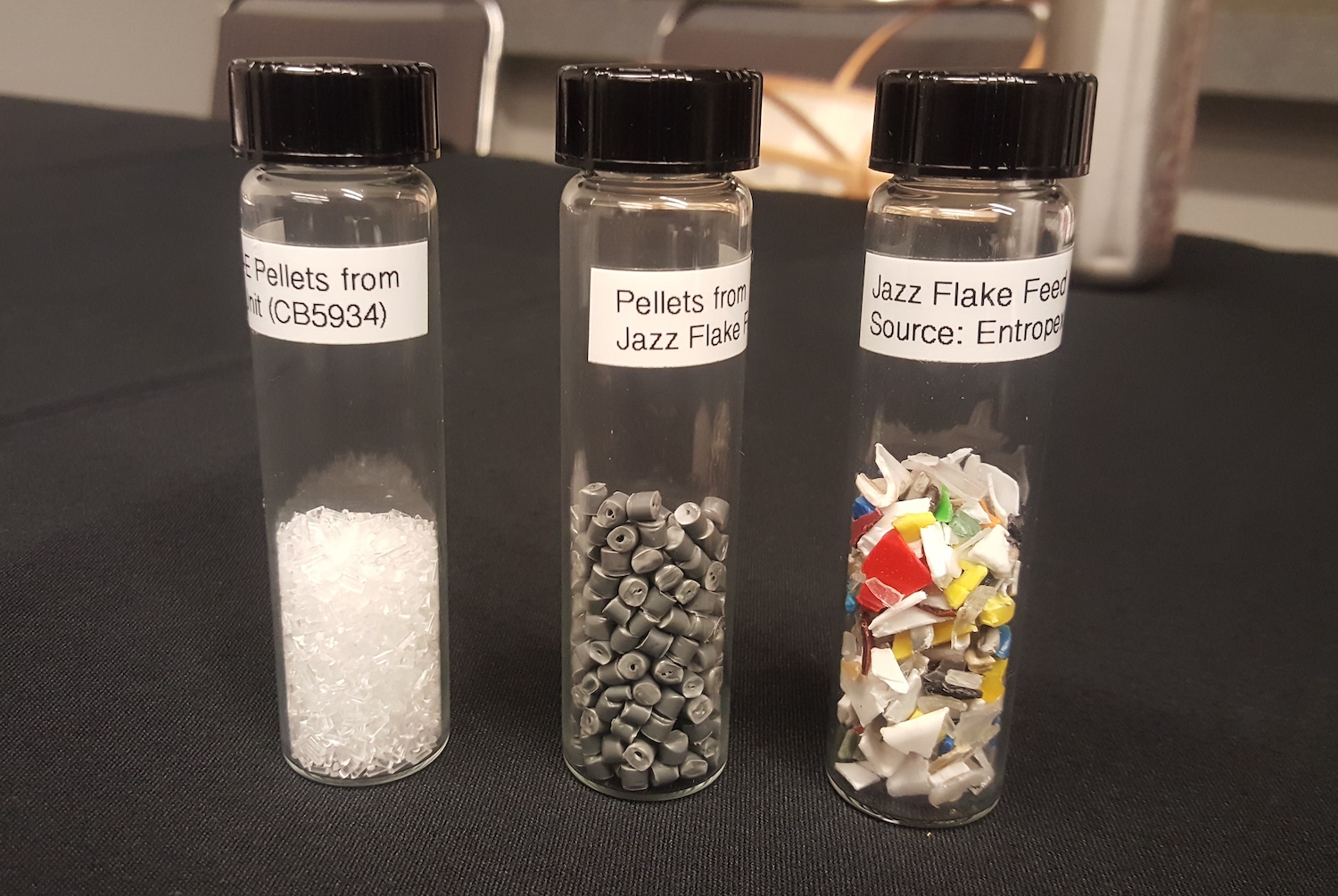
(Image: The vial on the right is filled with shredded polypropylene plastic. The vial in the middle contains flake created through existing polypropylene recycling methods, and the vial on the left—filled with clear plastic—is recycled polypropylene made with P&G's new process.)
P&G open-sources a new way to recycle plastic bottle caps
Most beverage bottles are made from polyethylene terephthalate (PET or Plastic No. 1), while the caps are made from polypropylene (PP or Plastic No. 5). This presents a recycling conundrum. When polypropylene is recycled, the resulting material is opaque and dark in color. Typically, the only choice is to down-cycle it into products like playground surfaces, significantly lowering its value in the recycling market. But this year, P&G changed all that.
The company's R&D team figured out a way to remove all colors and contaminants from recycled polypropylene, essentially returning it to its virgin state. The resulting material is clear, "so you can use it for another bottle or cap," Virginie Helias, P&G's chief sustainability officer, told TriplePundit. P&G open-sourced the technology so other companies can replicate it, and recycler PureCycle Technologies will utilize the system in a commercial facility set to open in Ohio this year.
Lush releases "carbon-positive" packaging
U.K. cosmetics company Lush is no stranger to sustainable packaging, having offered refillable packaging, packaging take-back programs and even packaging-free products for years. In 2019, the cult-favorite beauty brand took a different spin on the concept with the launch of what it calls "carbon positive" packaging. Made from biodegradable cork, the packaging pods released last year support regenerative cork forests in Portugal and are shipped via sailboat—meaning their supply chain returns more carbon benefit than it extracts, according to Lush.
Organic label Pete & Gerry's rolls out reusable egg cartons
Pete & Gerry's is the largest U.S. producer of free-range, organic, Certified Humane eggs. After years of offering take-back programs for its packaging, the company started testing a reusable alternative last year.
Through Pete & Gerry's model, reusable cartons are available for purchase at designated retail displays, and customers can refill them with loose eggs elsewhere in the store, which are discounted from a standard dozen for added incentive. The certified B Corporation piloted the effort at Hanover Co-op Food Stores in New Hampshire and Vermont in November and December, receiving a positive response from shoppers, said CEO Jesse Laflamme.
Kellogg brand Bear Naked creates recyclable food pouches
Flexible packaging offers a compelling set of environmental benefits compared to rigid plastics: It requires much less material and is far lighter, decreasing plastic use and transportation-related emissions per package. Resealable options like food pouches can also extend product shelf life and reduce food waste. But most flexible packaging isn't recyclable, presenting a key sustainability challenge for the companies using it.
Kellogg granola brand Bear Naked set out to change that by creating the industry's first fully recyclable stand-up pouch. The company and its partners re-imagined the typically complex and multi-layered package into a single film with a fully recyclable zipper. The pouches can be recycled at store drop-off points that accept plastic grocery bags although, like other plastic bags and films, they can't be recycled curbside.

Colgate-Palmolive invents a recyclable toothpaste tube
The new tube is made from high-density polyethylene (HDPE or Plastic No. 2), the same material as milk jugs and laundry detergent bottles, rather than layers of both aluminum and plastic. That means it can be recycled curbside wherever HDPE is accepted, without rinsing it out, the company told 3p.
Health-focused Colgate brand Tom's of Maine was the first to release the tube in November, and all full-size Tom's of Maine toothpastes will use this recyclable alternative by the end of this year. Colgate’s new vegan Smile for Good brand followed suit this month, and Colgate-Palmolive plans to open-source this sustainable packaging innovation so other companies can use it.
Image credits: UPS, Loop/Facebook, ThreeMain, Procter & Gamble, Pete & Gerry's, Mary Mazzoni, Tom's of Maine
How Drones Can Be an Important Tool to Upskill Youth
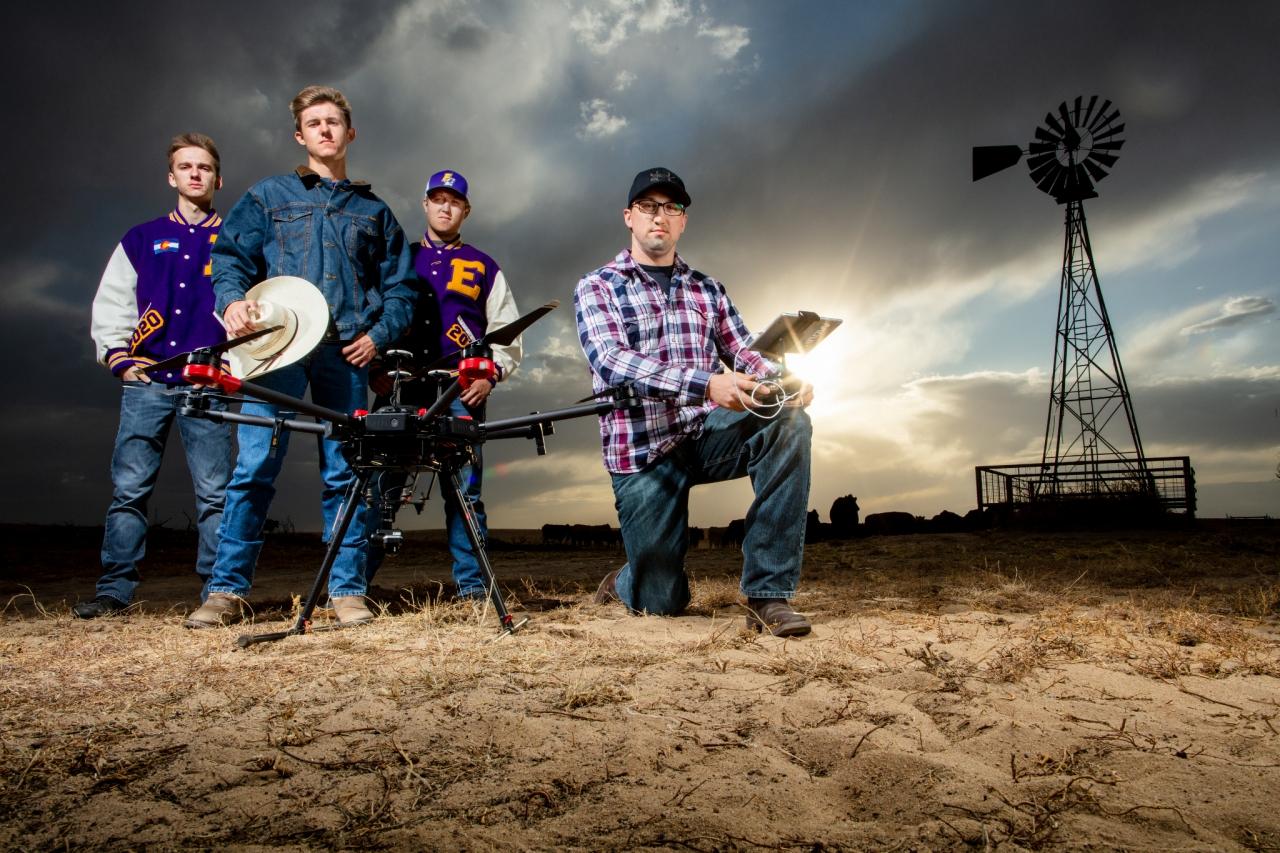
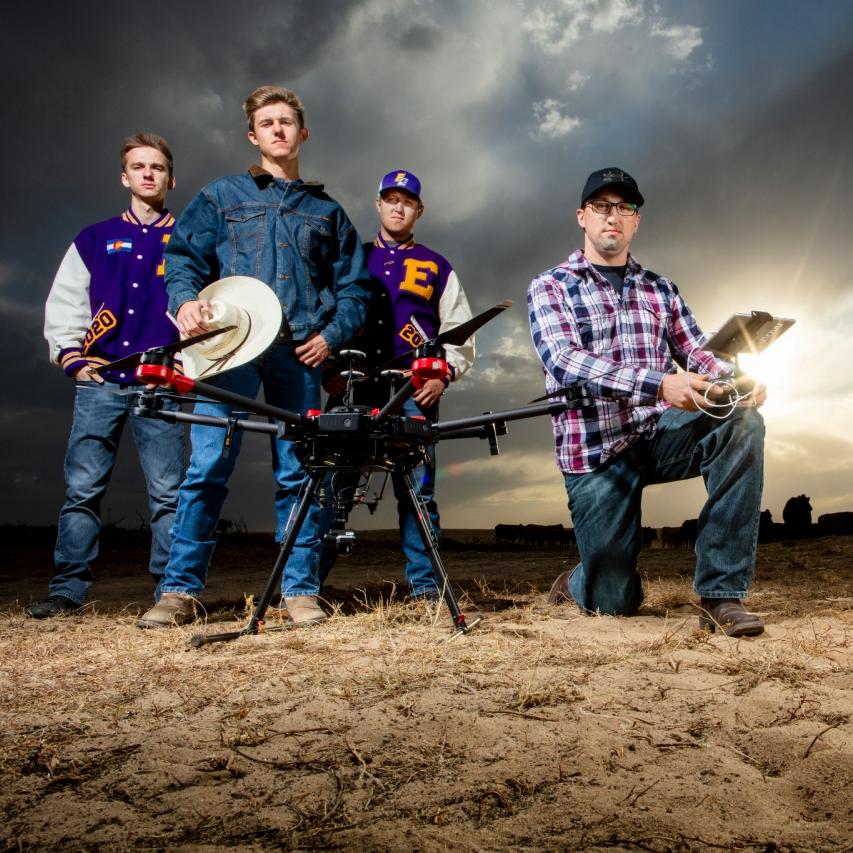
Arrow Electronics, a Fortune 500 electronic components and computer products distribution company, and the Nathan Yip Foundation, an organization that seeks expanded access to education worldwide, recently partnered on a high-school education project that reinforced several advantages of using drones for agriculture.
This STEM (science, technology, electronics and math) project taught youth at a high school in the town of Eads in eastern Colorado how to operate agricultural drones to improve ranching operations.
High-school students who are given the opportunity to learn to operate drones as part of their education are still considered rare – and lucky. However, efforts to educate the next generation of the workforce in drone technology are growing. Arrow’s project may be the first of many in response to drones becoming more important to the U.S. agricultural sector.
The agricultural drone market is skyrocketing and is expected to grow by almost 40 percent worldwide from 2018 to 2025. And the evidence suggests the benefits of drone technology stretch beyond the agriculture industry to society.
This Arrow-Nathan Yip Foundation project demonstrates three ways drones can benefit farmers, youth and the environment.
Drones can save a farmer’s time and money
Drones have become an important tool for sustainable farming. Farmers can fly drones over their fields or pastures to photograph the crops and livestock and retrieve information via technologies like infrared data. The tasks drones can help complete for farmers range from measuring crop density and growth to targeting thirsty areas in fields to probing for airborne pathogens that can lead to plant disease.
These improvements provide farmers with resources to increase crop quality and yields, which also results in higher profits and, of course, more food for consumers.
Youth can improve their tech skills by operating drones
During the Arrow Electronics project, youth gained agriculture and technology skills as they learned to build, fly and operate drones. Just a few other skills that youth develop from operating drones “on the field” include understanding Federal Aviation Administration (FAA) regulations and learning how to analyze the data from the drones to make agriculture decisions.
Agriculture is the primary industry in most rural areas; meanwhile, students living in more remote communities often have limited access to technology resources. Drones can help bridge that gap.
Teaching students how to operate agriculture drones is a win-win: Access to drones can help bridge gaps in technology while improving yields and eliminating inefficiencies within the agricultural sector.
In the case of the high-school project, Arrow’s partnership with the Nathan Yip Foundation was a success. “We are providing technology access to students in Eads that will both improve ranching operations and address the lack of resources often available in rural schools,” said Tarika Cefkin, executive director of the Nathan Yip Foundation, when interviewed recently for the company’s blog.
As drone technology continues to scale up worldwide, in sectors from agriculture to insurance to telecommunications, jobs in the field are growing. Projects akin to the one that Arrow Electronics supported have the potential to teach students cutting-edge skills that can support them in pursuing careers in drone technology.
Drones can be a net positive for the environment
Drones can also be used to prevent several types of environmental disasters. The “eyes in the sky” view that drones provide can spot risks that humans may not see; one example is ranchers’ use of drones to monitor and detect any health issues affecting livestock.
Thanks to drones, farmers can now more efficiently conduct experiments to improve their products — for example, students involved with the Arrow Electronics project used drones to test conditions to determine the healthiest options for crops or livestock.
Drones are also touted as a “green” technology tool because they can help monitor wildlife, inspect solar installations and hydropower projects, and detect sudden changes in climate data. The use of drones can also help farmers grow crops more sustainably, because instead of using tractors and quad bikes that require fossil fuels, farmers can rely on drones to pinpoint where pests are problematic or what areas of a field need more nitrates, allowing for more effective use of resources and preventing the overuse of fertilizers or pesticides.
Watch for drones to become more important to farmers and ranchers as new uses can help revolutionize the world of agriculture – one farm at a time.
Image credit: Arrow Electronics/3BL Media
Six Organizations Carrying on Martin Luther King Jr.’s Legacy
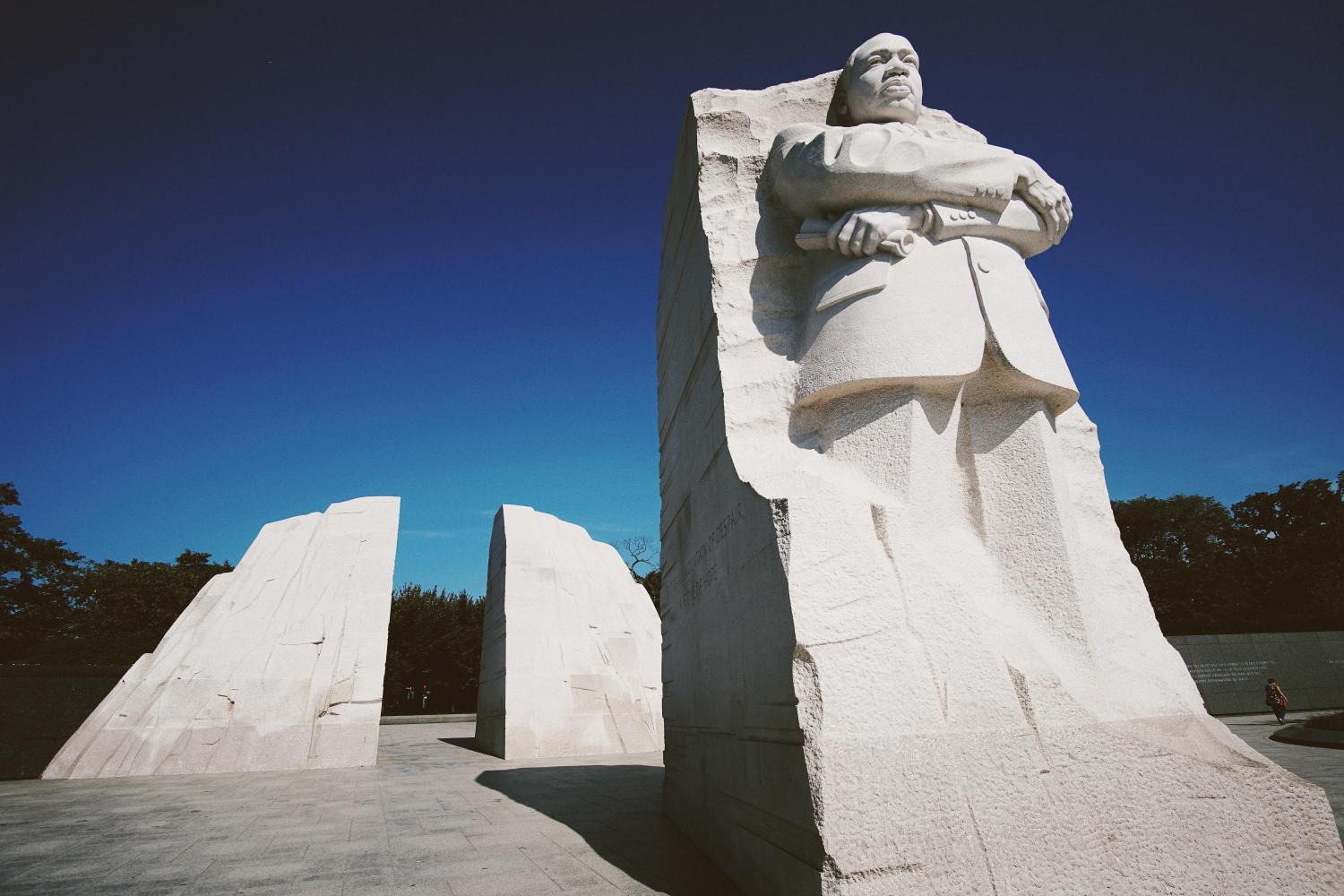
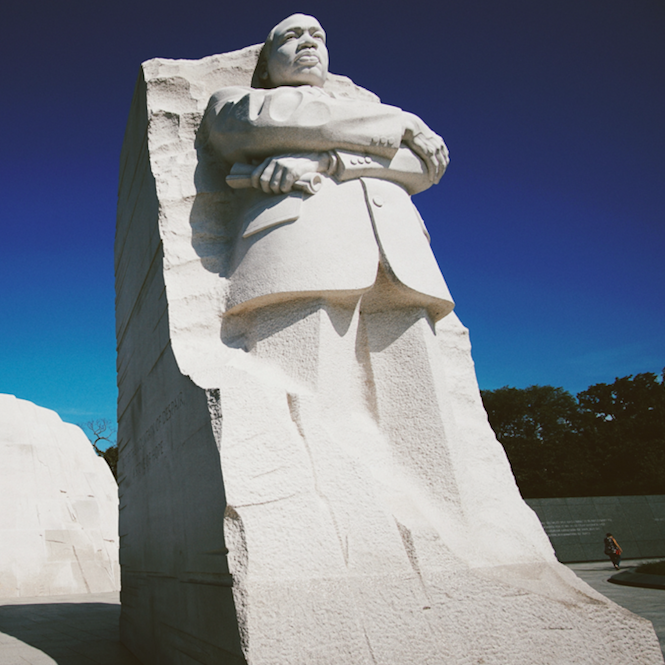
To mark today’s celebration of Martin Luther King Jr.’s legacy, the editorial team here at TriplePundit decided to highlight some organizations that are carrying on the spirit of his life's work: ending inequality and poverty through nonviolence means. If your company is looking for an organization to partner with — or donate funds or resources — as part of your social impact strategy, here are some organizations that stand out. Each of these groups is doing its part to take on inequality and poverty, stop violence, or expand leadership and economic opportunities to those who have been long overlooked.
Moms Demand Action
When it comes to groups women’s activism and service as a core focus, there's a long list of organizations to consider, including the League of Women Voters, Moms Clean Air Force and Zonta International. But as we reflected on King’s legacy of advancing social progress through nonviolence, we decided to showcase Moms Demand Action. When taking in the fact that gun violence in the U.S. keeps occurring with growing frequency, and our current ways of tackling this horror are not resulting in any changes for the better, we believe this group, which advocates for common-sense public safety measures, is worthy of individual and corporate support.
Poor People’s Campaign: A National Call for Moral Revival
This campaign takes its cue from one of King’s last planned initiatives before he was assassinated in April 1968. Like the one King was intent on pursuing, the Poor People’s Campaign seeks to confront problems including systemic racism, poverty, and environmental degradation in an attempt to give a voice to poor and marginalized communities. Activists working within this movement launched two successful initiatives during the summers of 2018 and 2019; this summer, with the 2020 election in mind, the Poor People’s Campaign plans to broaden its work to reach what it describes as the 140 million Americans who experience, or are at risk for, discrimination, financial struggles or environmental injustice on a daily basis.
RAICES Texas
Yes, there are still kids in cages, and too many (face it, one child is too many) spent Christmas in such conditions. But while this story has largely receded from news headlines, small but mighty RAICES is doing what it can to seek justice for people who are escaping violence and seeking a better life. The group has been fearless in calling out some of America’s most trusted brands, and is determined to harness what resources it can to provide free or low-cost legal services to immigrant families while fighting for migrant’s rights.
Southern Poverty Law Center
Violent hate crimes have been increasing over the past few years here in the U.S. For almost half a century, the Southern Poverty Law Center (SPLC) has been monitoring hate groups, in addition to promoting tolerance through various education programs.
Southern Christian Leadership Conference
The Southern Christian Leadership Conference (SCLC), which dates back to King’s leadership and victory with the Montgomery Bus Boycott of 1957, is still going strong as it grooms young leaders to this day. The SCLC’s various chapters across the U.S. take on various social challenges, including leading the fight against injustice, boosting voter registration and ending human trafficking.
The Trevor Project
There is no shortage of nonprofits that seek to protect and secure human rights for the LGBTQ community. Which reminds us: As King’s wife, Coretta Scott King, continued his work, LGBTQ rights was among the many challenges for which she fought until she died in 2006. To that end, The Trevor Project stands out as it offers crisis intervention and suicide prevention services to at-risk LGBTQ youth. One focus for the organization is its “50 Bills, 50 States” campaign, which seeks to end the harmful practice of conversion therapy in every U.S. state.
Image credit: Brian Kraus/Unsplash
Going 100 Percent Renewable in 2020, PepsiCo Pushes Ahead on Climate Action Plan
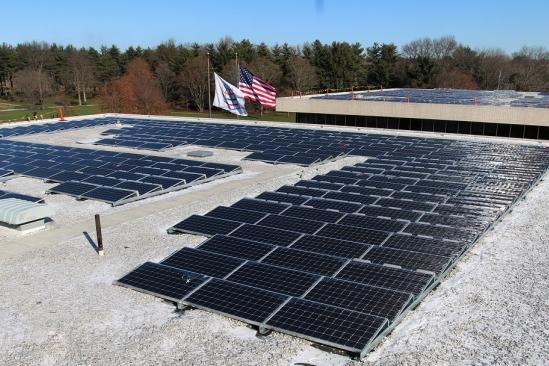
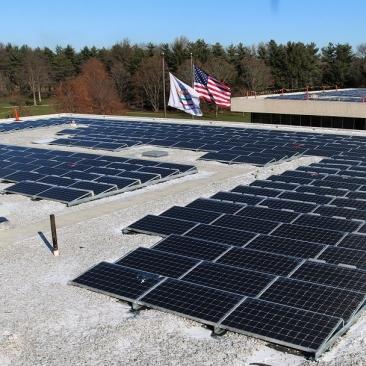
PepsiCo recently announced plans to power its direct U.S. operations with 100 percent renewable energy by the end of this year. That means mainstream products like Gatorade, Lay’s, Bubly, Pepsi and more will soon be powered with wind and solar energy. The company’s U.S. operations account for almost half of its total global electricity use.
“PepsiCo is pursuing 100 percent renewable electricity in the U.S. because the severe threat that climate change poses to the world demands faster and bolder action from all of us,” said Ramon Laguarta, chairman and CEO of PepsiCo.
PepsiCo building on past efforts
PepsiCo’s announcement builds on its past efforts, including the recent installment of solar panels at its global headquarters in Purchase, New York.
There are solar power installments at PepsiCo facilities across the U.S., with one example in Modesto, located in California’s Central Valley. In 2008, PepsiCo installed a solar energy system on the roof of that Frito-Lay plant. The same year, the company installed 54,000 square feet of solar concentrators on five acres of the same facility. Since that project, the Frito-Lay plant has become a keystone Near-Zero Emission Project for the state of California, which includes zero-emissions vehicles and forklifts, as well as new on-site energy storage systems.
PepsiCo’s efforts to install renewable electricity are not limited to the U.S. Nine countries in the company’s European direct operations meet 100 percent of their electricity needs from renewables. In 2016, the company’s Mexico Foods business started a power purchase agreement to source wind energy. By 2018, 76 percent of the PepsiCo Mexico Foods' electricity needs were met through wind energy.
And Mexico is not the company’s only Latin American operations to use renewable energy. Another facility in San Pedro Sula, Honduras, uses a 3-megawatt solar rooftop display to offset 20 percent of its power use. It was the largest rooftop photovoltaic system in Latin America until 2015.
PepsiCo’s efforts to meet its renewable energy goals in the U.S. will mirror what it has already accomplished globally. The company will use power purchase agreements and virtual power purchase agreements, which finance the development of renewable energy projects, as well as renewable energy certificates (RECs). The company’s portfolio will have more renewable energy certificates in 2020, and by 2025 there will be more power purchase agreements and virtual power purchase agreements.
Focusing on renewables will help PepsiCo meet its emissions reduction goal
PepsiCo’s plans to power its U.S. operations with renewable energy will help it meet its goal to reduce greenhouse gas emissions by 20 percent across the value chain by 2030. Its shift to renewables will reduce greenhouse gas emissions from direct operations in the U.S. by 20 percent. Given that electricity generation in the U.S. accounts for 28 percent of greenhouse gas emissions, renewable energy is a smart focus.
PepsiCo seeks a more sustainable food system
PepsiCo says it's looking to help build a more sustainable food system, and renewable energy is a part of that plan. The company’s chief sustainability officer, Simon Lowden, said: “As an industry leader, we have a responsibility to help spur the use of renewable energy in the U.S., while encouraging the kind of systemic change that can build a more sustainable food system.”
Other aspects of building a more sustainable food system include what it terms a “next generation” agriculture strategy. One aspect of that strategy is the Sustainable Farming Program Continuous Improvement Process, described as “a cyclical process geared towards assessing and then addressing sustainability opportunities at the farm level within PepsiCo’s agricultural supply chain.” It requires traceability. Each supplier must be able to the farms it sourced from.
PepsiCo is doing better than its biggest rival to reduce emissions
The company’s rival, Coca-Cola, proclaims it is “committed to making changes in our operations to reduce our climate impact.” Yet the company seems to not be doing as well as PepsiCo is to reduce its emissions, as it admits on its website that it is “off-track” and its greenhouse gas emissions are 10 to 15 percent higher than its 2004 baseline. The beverage giant attributes the growth in emissions to volume growth outpacing emission ratio improvements and insourcing of external manufacturing processes.
Last week marked a busy week for climate action announcements by various industry leaders. Visa achieved its 100 percent renewable power goal, while Microsoft announced it would strive to become “carbon negative” by 2030.
Image credit: PepsiCo
It’s the End of CSR as We Know It, and I Feel Fine
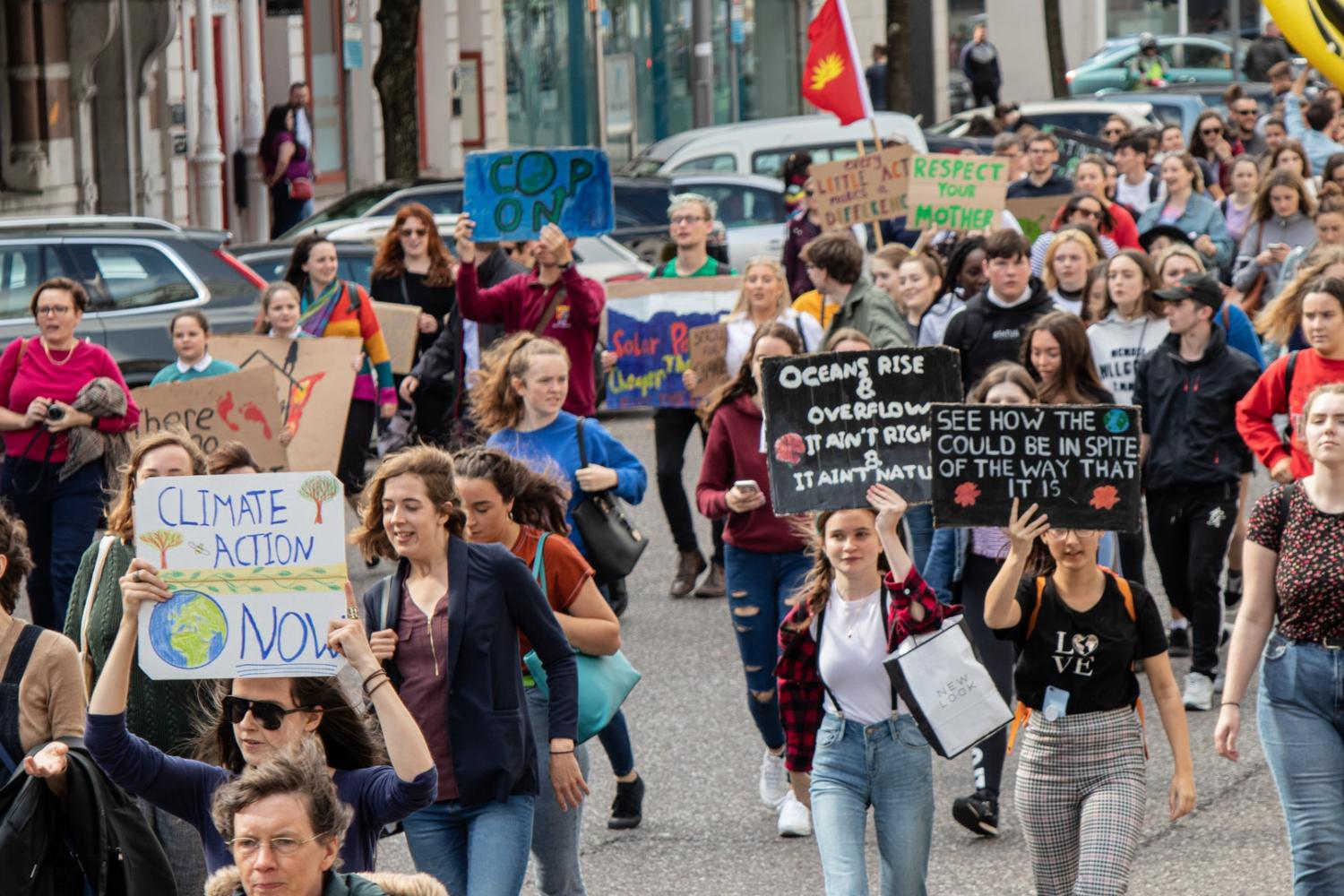
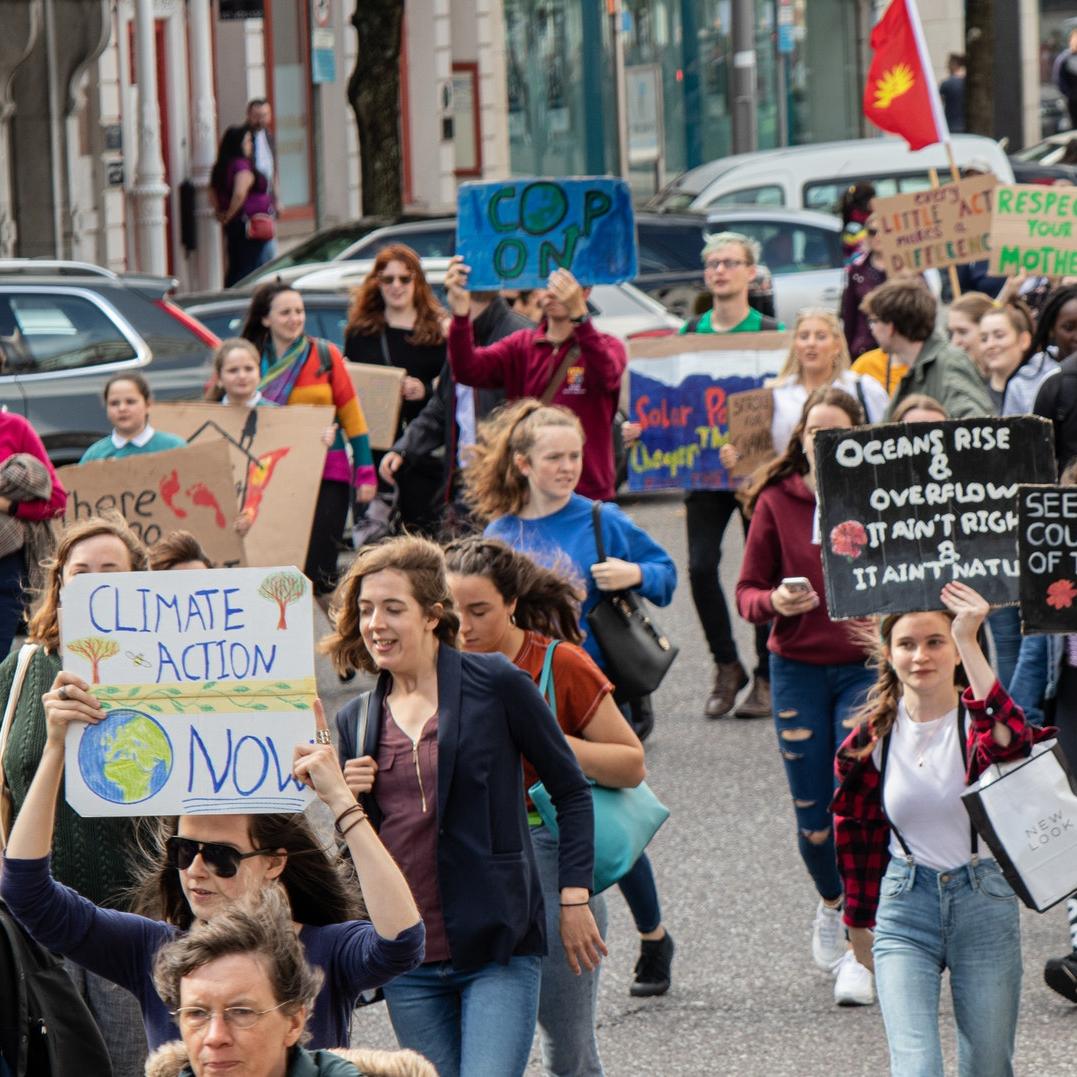
In 1953, Dr. Howard Bowen coined the term corporate social responsibility (CSR), asserting that business leaders are morally obligated to consider social consequences – a responsibility that can supersede their obligations to shareholders.
I imagine Bowen envisioned a leader, brow furrowed, weighing how the tools at their disposal – product development, employee welfare, philanthropy, or other means – might help solve a societal problem, and circumspectly pulling the best lever at their disposal only to rise the next morning and face a new challenge with the same high-stakes.
This was not for the faint of heart. In fact, CSR was intended to get your heart rate up.
Unfortunately, in the 70 years since, pulses have stayed at far too comfortable a level.
CSR has become a catchall. Corporate donations. Cause marketing. Employee matching. Environmental sustainability. Supply chain management. Volunteerism.
Structures vary widely from company to company. Very few programs are led by someone at a c-suite level. There is no widespread, recognized professional training. There are no certification bodies or audit functions of record to help companies measure and manage the quality of a social good portfolio. Social responsibility programs often lack ambition, and worse – have been used as fig leaves. Too few CSR functions passionately demand excellence.
To be clear – there is some excellent work that some corporations have done under the banner of CSR. But by and large – CSR is not a signal of ingenuity, ethics, and action. It is not the moral anchor, pulling a leader toward integrity.
Until now.
Bowen argued that the two most important conditions for successful CSR are that 1) business leaders must recognize the social responsibility of their work, and 2) the public must care that businesses and business leaders uphold these responsibilities.
The 2020s will usher in an era in which both conditions are finally true.
The major issues facing society, whether global – think climate change and the refugee crisis – or local – think homelessness and food access – have never been more present in daily life. Social consciousness has become part of the zeitgeist.
Leaders are recognizing their responsibility. Last summer, under the umbrella of the Business Roundtable, some of the country’s most influential CEOs declared that companies should put social responsibility above profit. While this statement is only as valuable as the time, focus and – yes – money corporate leaders commit to making it true, the statement itself is unprecedented and important. What’s more, some leaders aren’t simply joining traditional corporate ranks to effectuate this change – they are building their companies with social responsibility as a cornerstone. Look no further than the likes of Allbirds or Sweetgreen to see this in action.
So too, the public is holding business leaders to account. For the twelfth year in a row, Edelman’s trust index shows people trust business more than government. For many, this translates into a belief that business is uniquely suited to help solve society’s most pressing problems. And say what you want about millennials and Gen-Zers, but they are a huge force in holding business’ feet to the fire. Statistically, a successful social responsibility effort influences where this portion of the population chooses to work, how they use their purchasing power, and how they lead (NB: The CEOs from Allbirds and Sweetgreen are millennials).
The time is nigh. Whatever you want to call it – CSR, ESG, or social impact – leaders who build this muscle into the fabric of their organizations for real – replete with c-suite leadership, board representation, management systems, and audits – will create better companies as a result, and these businesses will make our world better. Those who don’t will do so at their organization’s peril.
The 2020s will be the decade of the furrowed brow and the elevated heartbeat. I think that would make Howard Bowen smile.
Image credit: Saph Photography/Pexels

